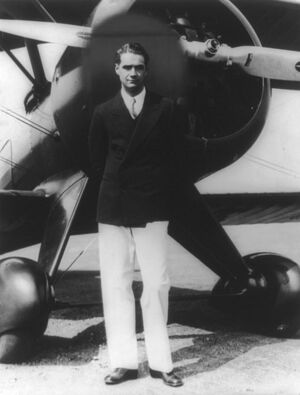Howard Hughes (nonfiction)
Howard Robard Hughes Jr. (December 24, 1905 – April 5, 1976) was an American businessman, investor, pilot, film director, and philanthropist, known during his lifetime as one of the most financially successful individuals in the world.
He first made a name for himself as a film producer, and then became an influential figure in the aviation industry.
Later in life, he became known for his eccentric behavior and reclusive lifestyle—oddities that were caused in part by a worsening obsessive–compulsive disorder (OCD) and chronic pain from a plane crash.
As a maverick film tycoon, Hughes gained prominence in Hollywood beginning in the late 1920s, when he produced big-budget and often controversial films like The Racket (1928), Hell's Angels (1930), and Scarface (1932). Later he controlled the RKO film studio.
Hughes formed the Hughes Aircraft Company in 1932, hiring numerous engineers and designers. He spent the rest of the 1930s setting multiple world air speed records and building the Hughes H-1 Racer and H-4 Hercules (the Spruce Goose). He acquired and expanded Trans World Airlines and later acquired Air West, renaming it Hughes Airwest. Hughes was included in Flying Magazine's list of the 51 Heroes of Aviation, ranked at No. 25.
Hughes was involved in a near-fatal aircraft accident on July 7, 1946, while performing the first flight of the prototype U.S. Army Air Forces reconnaissance aircraft, the XF-11, near Hughes airfield at Culver City, California. An oil leak caused one of the contra-rotating propellers to reverse pitch, causing the aircraft to yaw sharply and lose altitude rapidly. Hughes attempted to save the aircraft by landing it at the Los Angeles Country Club golf course, but just seconds before reaching the course, the XF-11 started to drop dramatically and crashed in the Beverly Hills neighborhood surrounding the country club. When the XF-11 finally came to a halt after destroying three houses, the fuel tanks exploded, setting fire to the aircraft and a nearby home. Hughes sustained significant injuries in the crash.
Many attribute his long-term dependence on opiates to his use of codeine as a painkiller during his convalescence.
Shortly before the 1960 Presidential election, Richard Nixon was alarmed when it was revealed that his brother, Donald, received a $205,000 loan from Hughes. It has long been speculated [by whom?] that Nixon's drive to learn what the Democrats were planning in 1972 was based in part on his belief that the Democrats knew about a later bribe that his friend Bebe Rebozo had received from Hughes after Nixon took office.
In 1972, Hughes was approached by the CIA to help secretly recover Soviet submarine K-129, which had sunk near Hawaii four years earlier. The recovery plan used the special-purpose salvage vessel Glomar Explorer. Hughes' involvement provided the CIA with a plausible cover story, having to do with civilian marine research at extreme depths and the mining of undersea manganese nodules. In the summer of 1974, Glomar Explorer attempted to raise the Soviet vessel.
Today, his legacy is maintained through the Howard Hughes Medical Institute.
In the News
Fiction cross-reference
Nonfiction cross-reference
External links:
- Howard Hughes @ Wikipedia
